20 hallway panelling ideas to add depth and texture to your home
Create a hallway that impresses from the first step with these unique panelling ideas
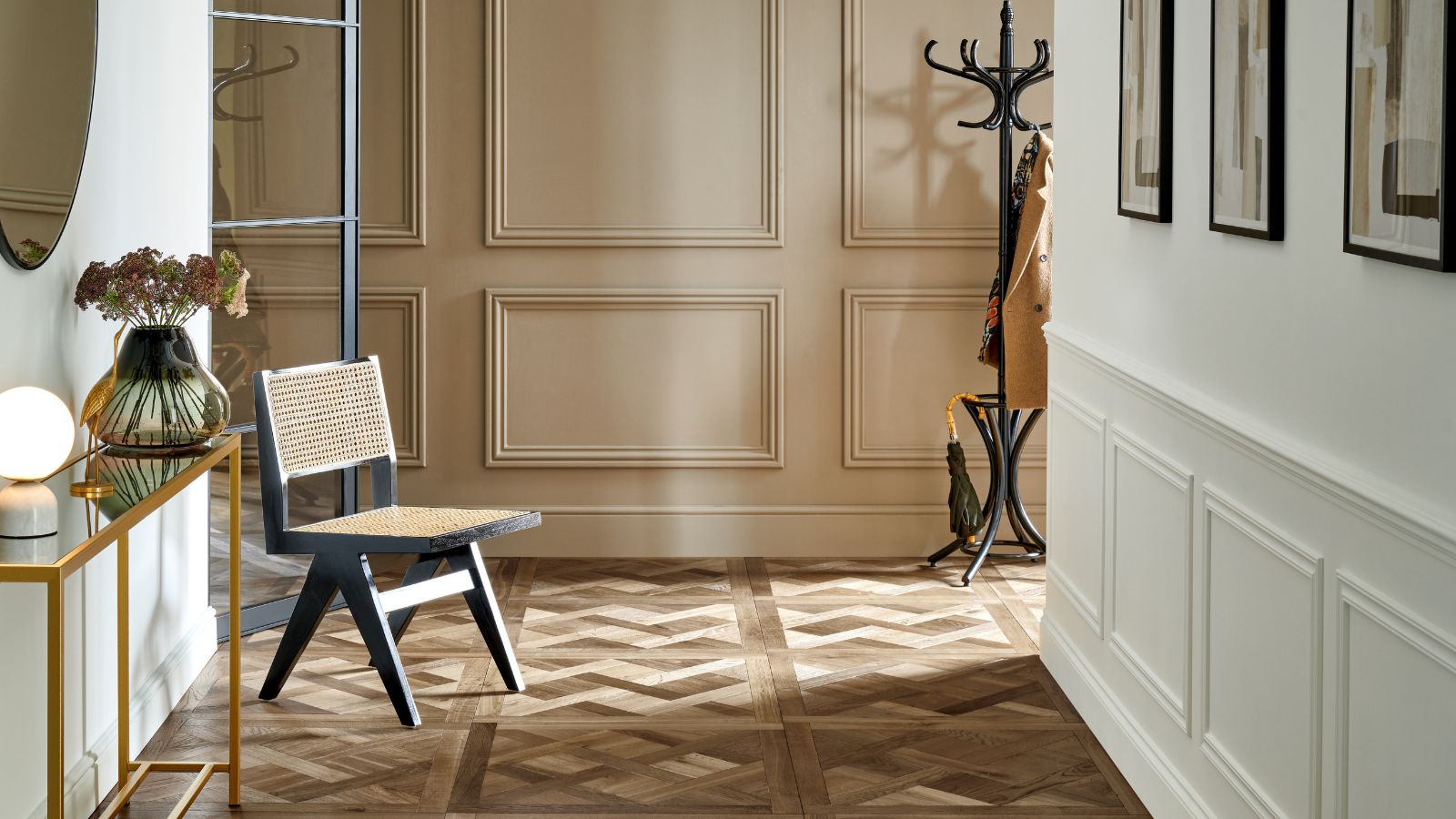
Do you ever feel like your hallway is just a space to pass through? It doesn’t have to be. Often overlooked, hallways have the potential to set the tone for the rest of your home, and one of the simplest and most effective ways to elevate these spaces is by adding wall panelling.
From classic tongue and groove panels to sleek, modern designs, panelling can instantly transform a plain hallway into a stylish and welcoming space. Whether you're aiming for a cosy, country aesthetic or a bold, contemporary look, there's a panelling style that suits every taste and home.
To help you enhance your hallway design, we’ve asked experts for their insights and gathered inspiration for beautiful panelling ideas.
Hallway Panelling Ideas: What to consider
Not sure how to decide which of these wall panelling ideas will work best in your home? Jessica Davis, Founder of Library Ladder Company, shares her top tips for knowing what type of wall panel will work for your space:
Your home aesthetic
"Choosing the right style of wall panelling depends on several factors. First, consider the overall aesthetic of your home – is it more traditional or contemporary? Classic panel styles like wainscoting or shaker panelling complement period homes, while sleek, 3D linear or geometric designs suit modern spaces."
The height & light in your hallway
"The height of the hallway is also key; taller panels can create the illusion of higher ceilings, while half-wall panels add a touch of warmth without overwhelming small hallways.
Additionally, lighting and hallway size matter – lighter-coloured panels can open up narrow spaces, while darker tones create drama and elegance in larger hallways."

Jessica, founder of LLCompany, has 19 years of design experience and specialises in transforming spaces with wall panelling. Her expert knowledge helps homeowners choose the right styles and materials for beautiful, functional interiors.
20 Hallway Panelling Ideas
1. Try traditional tongue and groove cladding for a 'country' look
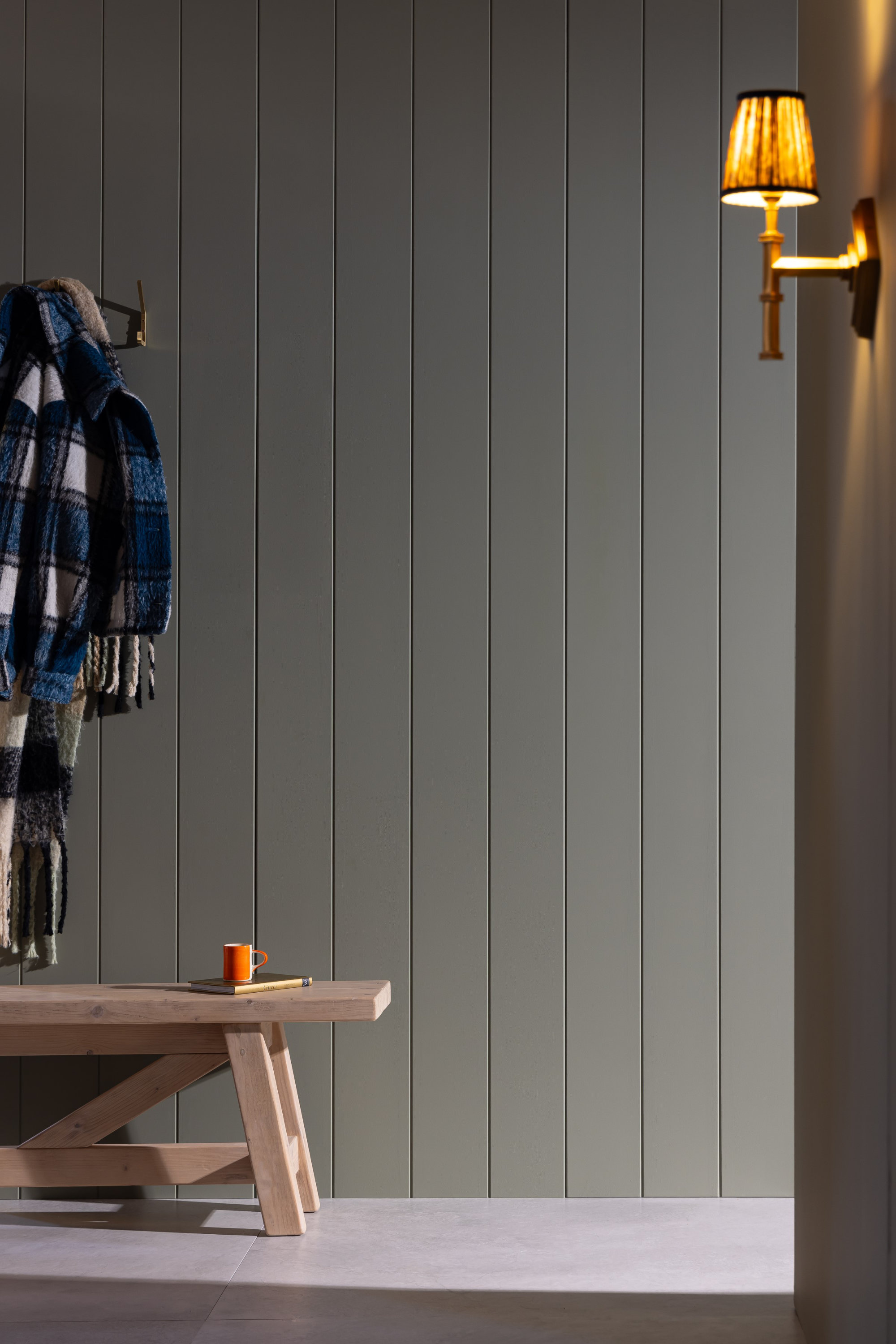
If you're seeking a cosy, rustic aesthetic feel, tongue and groove cladding might be the perfect choice for transforming your hallway into a countryside-inspired space. This style of panelling, often associated with cottages and country homes, adds warmth and texture to what can sometimes be a purely functional area. What's more, tongue and grove can be used to conceal an otherwise patchy or textured wall beneath.
To enhance the country feel, consider pairing this type of wall panelling with natural wood finishes or soft, muted shades of paint like sage green or off-white. Opt for a satin or gloss finish paint and moisture-resistant woods, such as oak or pine, as these not only add durability but also ensure your panelling withstands the wear and tear of high-traffic areas like hallways.
2. Use half-wall panelling to add dimension
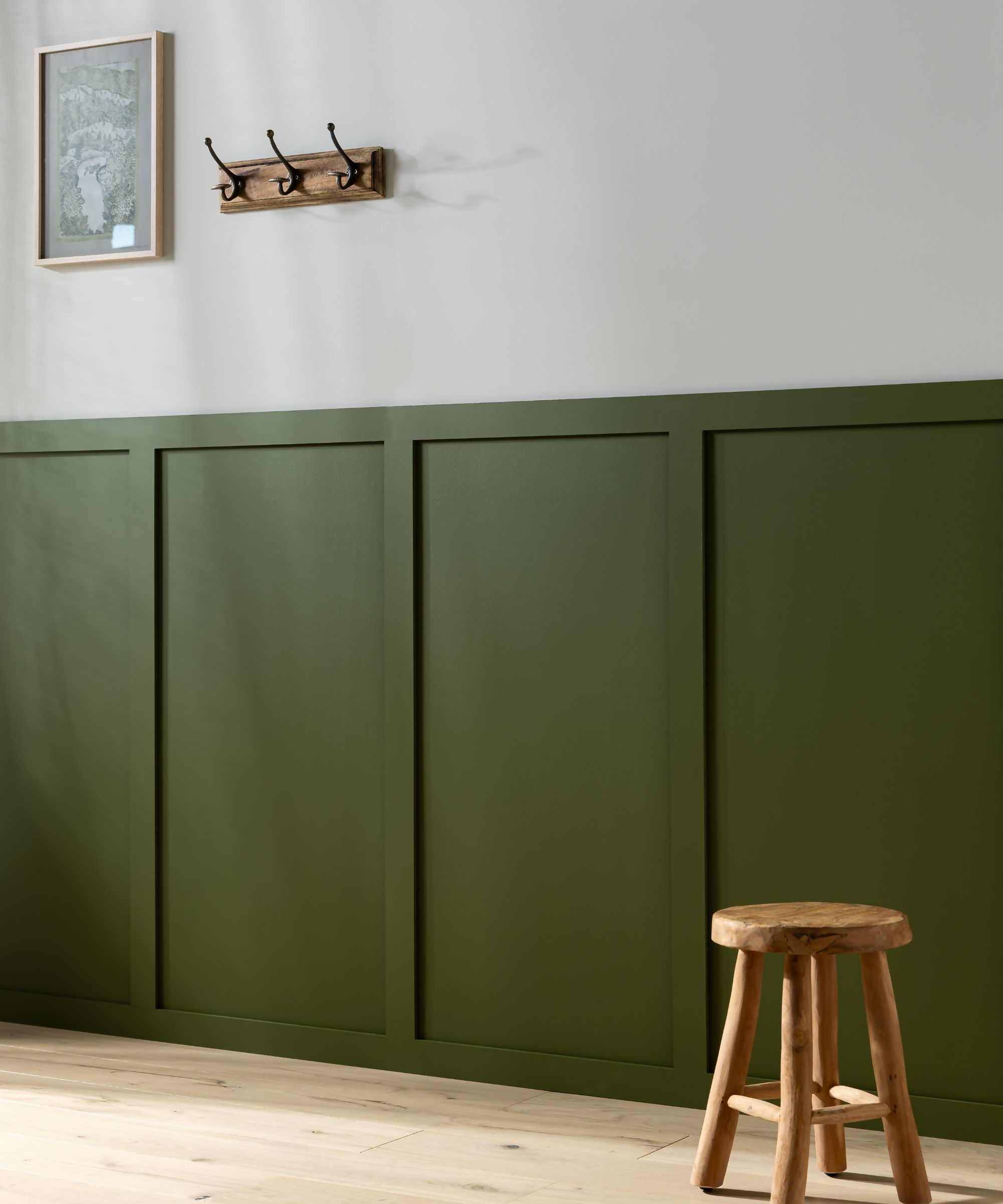
"If it's a pared back look you are after, consider going for half height panelling," says Olivia Crosher, interior design at Naturewall. "Whether that be tongue and groove or a reeded profile that can be painted a neutral colour slightly darker than the wall above."
By vertically breaking your hallway into two distinct sections, you can play with different colours and textures to make your space feel more dynamic. Plus, half-wall panelling is practical, too. The panels protect the lower half of the wall from scuffs and marks, perfect for entryways where guests may be shedding raincoats and little ones can kick off muddy boots.

Olivia is an interior designer and Visual Content Lead at Naturewall, purveyors of cutting edge wall panelling for hallways and inteirors. Olivia leads direction on photography, videography, set design and styling for Naturewall products.
3. Add pegs or hooks to your panels to hang coats and bags
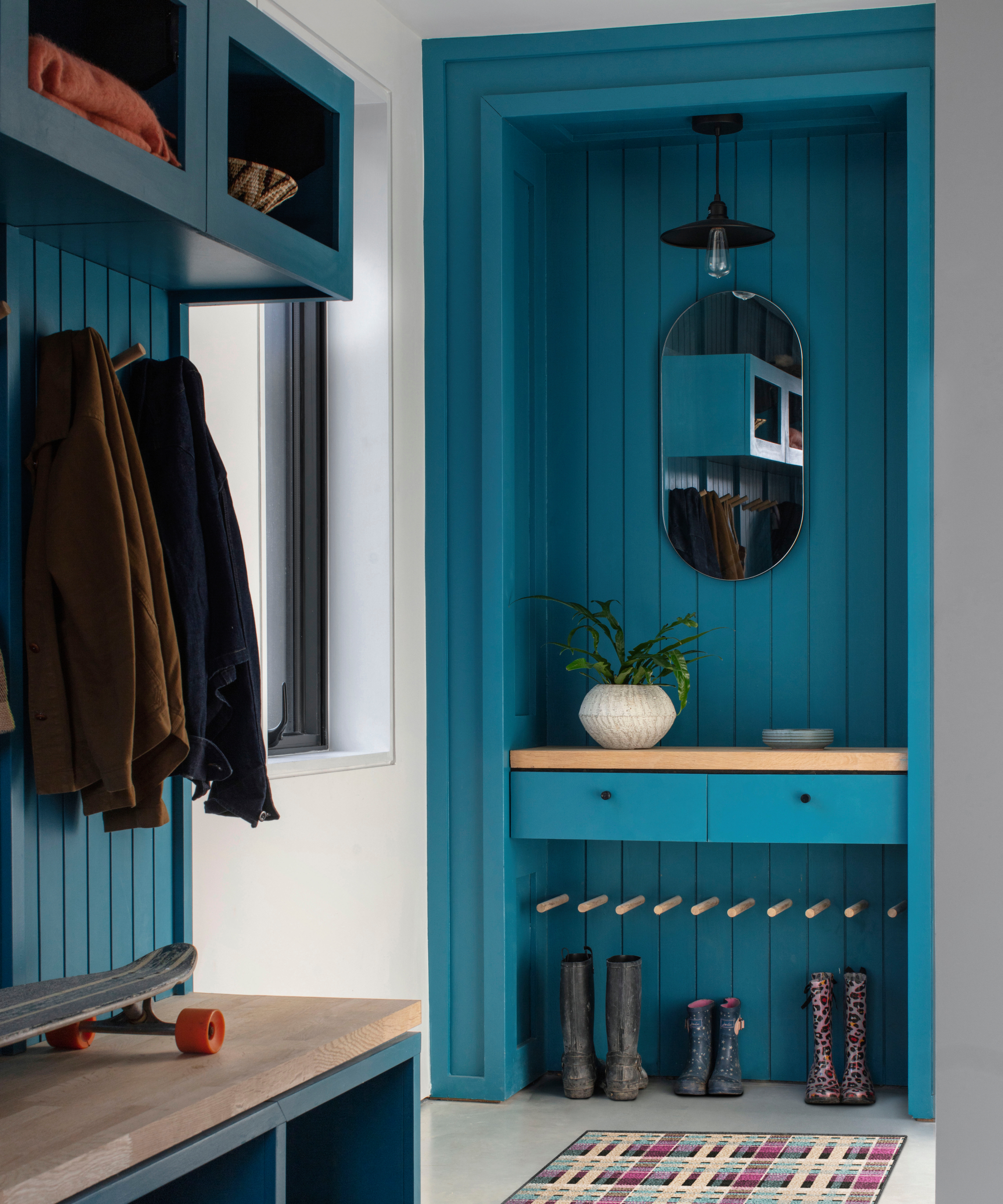
"Coat hooks or rails can be added discreetly to wall panels for a clean, organised look," explains Jessica Davis from LL Company. These clever additions keep the hallway clutter-free while also turning everyday items into part of your décor.
For a more tailored look, consider positioning the hooks within the panelled sections for a built-in feel. Not only does this make everyday items easy to access, but it also helps turn those items – like colourful coats or patterned bags – into a part of the design. This small but impactful detail works especially well in busy households where keeping the hallway tidy is key. Plus, it’s a great way to maximise wall space in narrower hallways, ensuring everything has a place without adding bulky furniture.
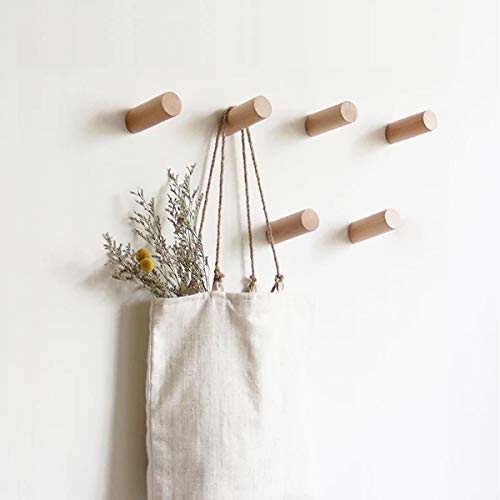
These easy-to-install wall hooks can be added to your hallway wall panelling to hang and organise all kinds of bags, coats, hats, and scarves.
4. Or conceal built-in storage within your panelling
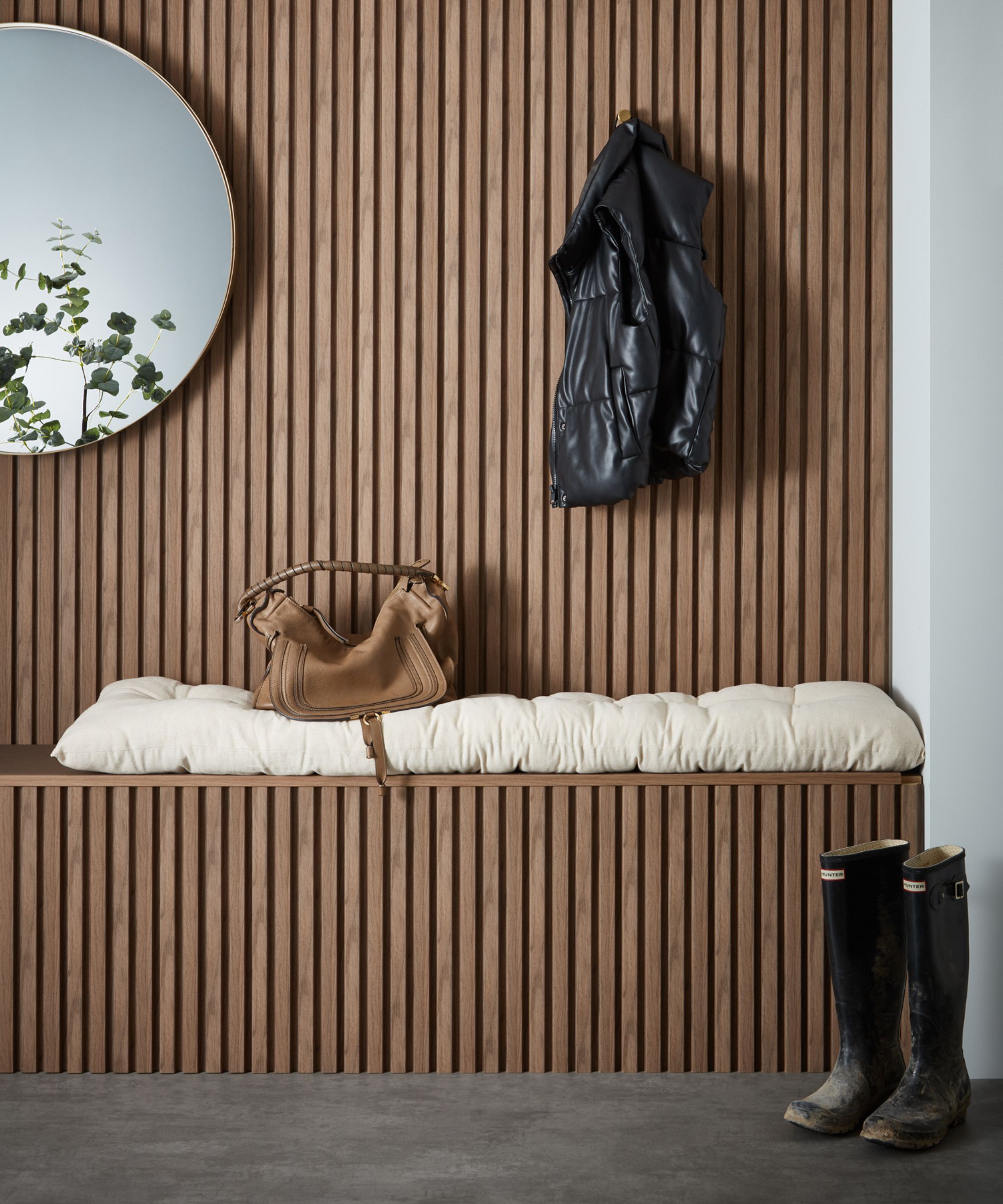
Maximising storage without sacrificing style can be a challenge, especially in smaller hallways. One smart solution? Conceal built-in storage within your panelling. Hidden cabinets or drawers within the panelling allow you to tuck away everyday items, all while maintaining a clean, streamlined look.
As Jessica Davis explains, “Panelling can cleverly double as functional hallway storage. Consider integrated cabinetry or hidden compartments within the lower panels –particularly useful in smaller hallways where space is at a premium.”
In the example above by Naturewall, vertical slatted walnut panelling adds visual texture while cleverly concealing a built-in bench with storage underneath. This seamless design offers both a stylish seating area and a practical storage solution.
5. Try DIY beadboard panelling for an affordable transformation
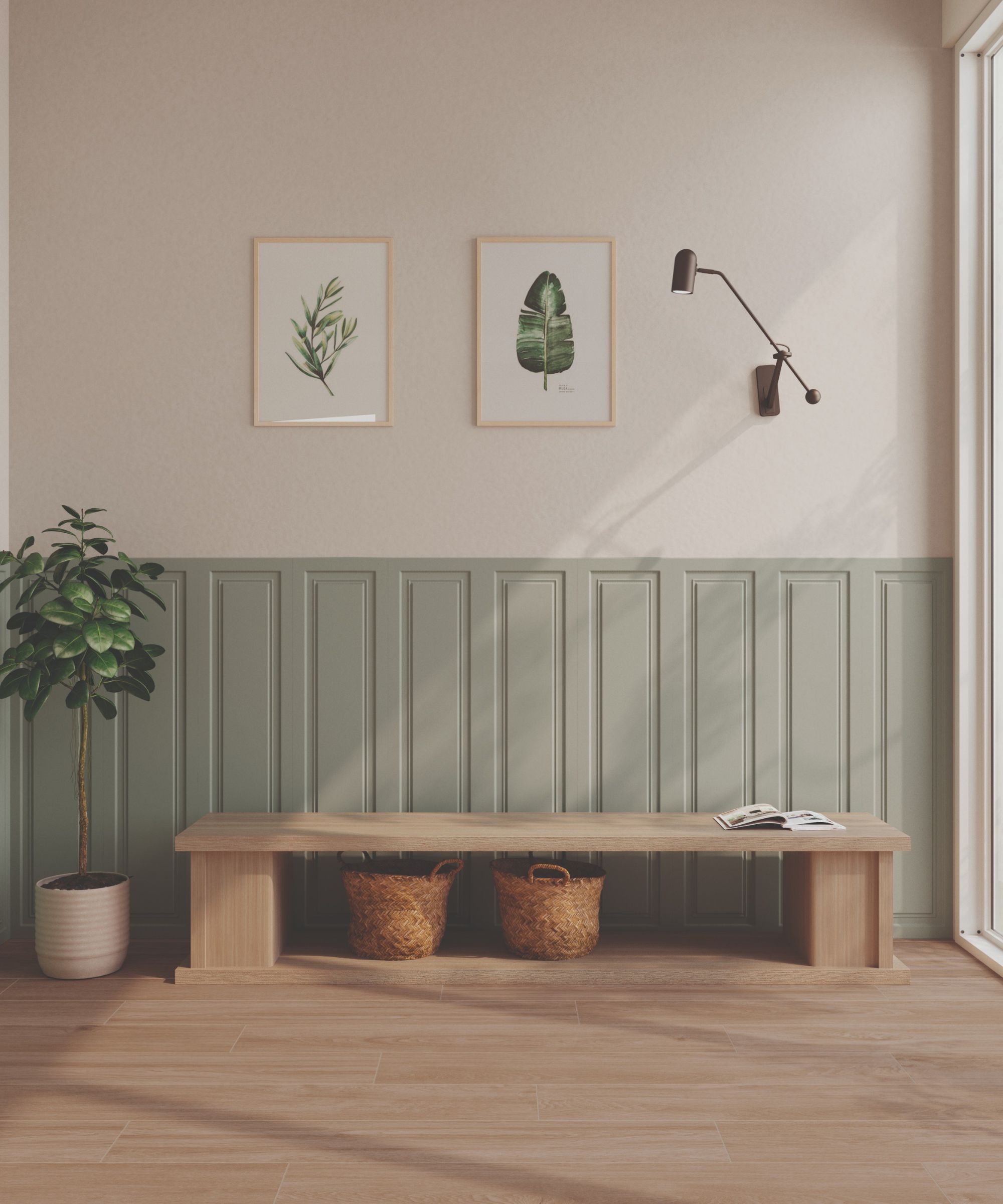
Looking to transform your hallway on a budget? DIY beadboard panelling is an easy and affordable option. Its distinctive vertical grooves add instant character to a space, making it a great choice for smaller hallways where you want to make an impact without overwhelming the room.
To get started, you can find beadboard panels at most DIY stores – try DIY.com or Cut My –often in pre-cut sheets that are simple to install. All you need is adhesive, a saw for trimming, and paint to match your scheme.
Beadboard works well with a range of looks: paint it in crisp white for a coastal feel or try muted tones or soft greys for a more contemporary aesthetic. It’s also a great fit for traditional country-style homes. Just make sure to apply a protective finish, especially in high-traffic areas like hallways, to keep it looking fresh for longer.
6. Opt for wainscoting for a sophisticated touch
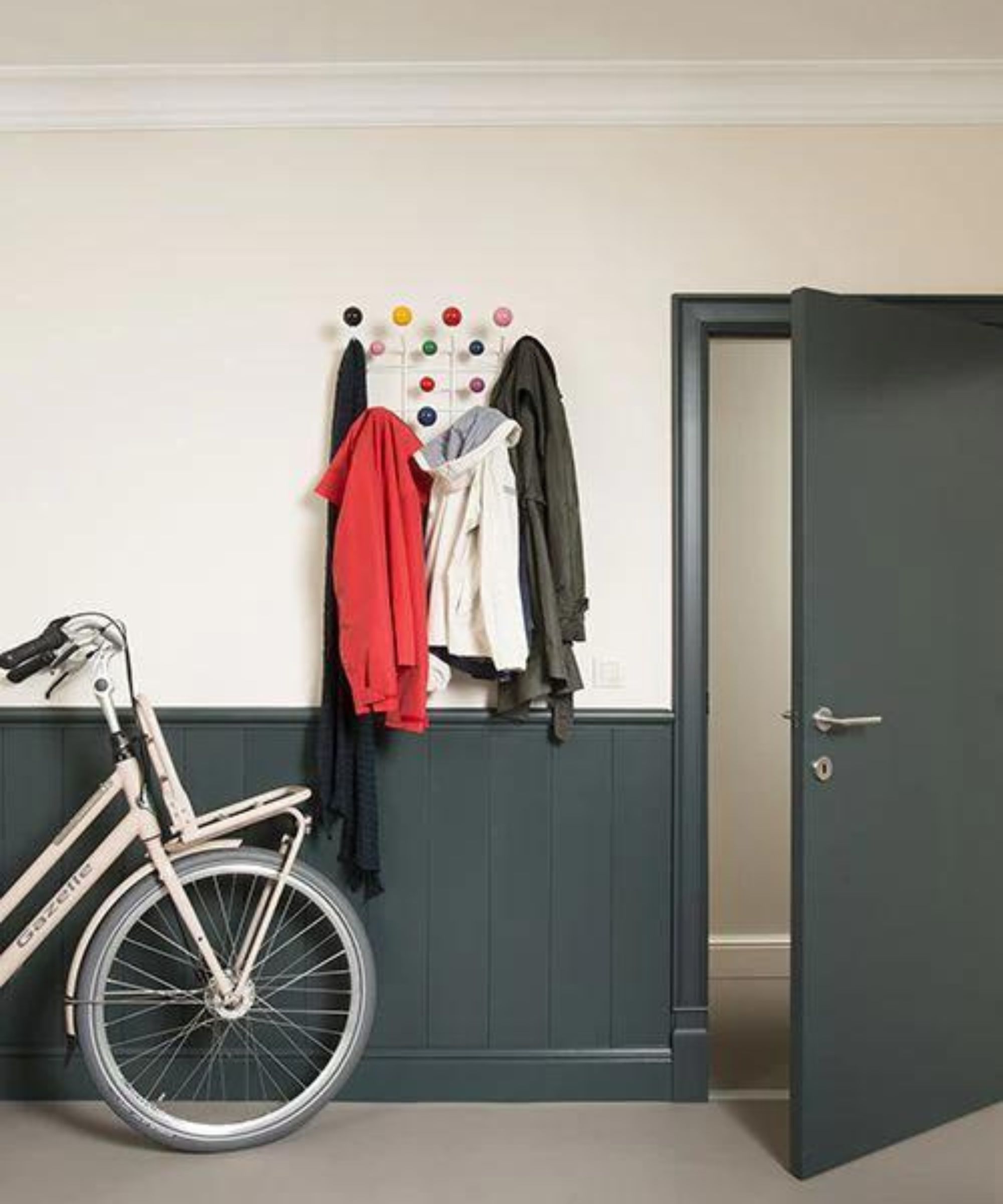
"Traditional wall panelling has been making a strong comeback, with its timeless aesthetic making it a classic choice for homes," explains Olivia Crosher, interior design at Naturewall. "Bringing in subtle detail, wainscotting panelling adds a touch of elegance to a room, injecting interest to flat walls. These traditional styles are on trend due to their ability to work in a range of interiors, as they can be painted any colour to match your hallway scheme."
Olivia continues, "For those wanting maximum effect, full height wainscotting in a dark or bold colour creates the wow factor on entry to a home. Taking this panelling to the ceiling in a hallway is also a great way of making the space look bigger."
7. Or embrace a timeless shaker style wall panel
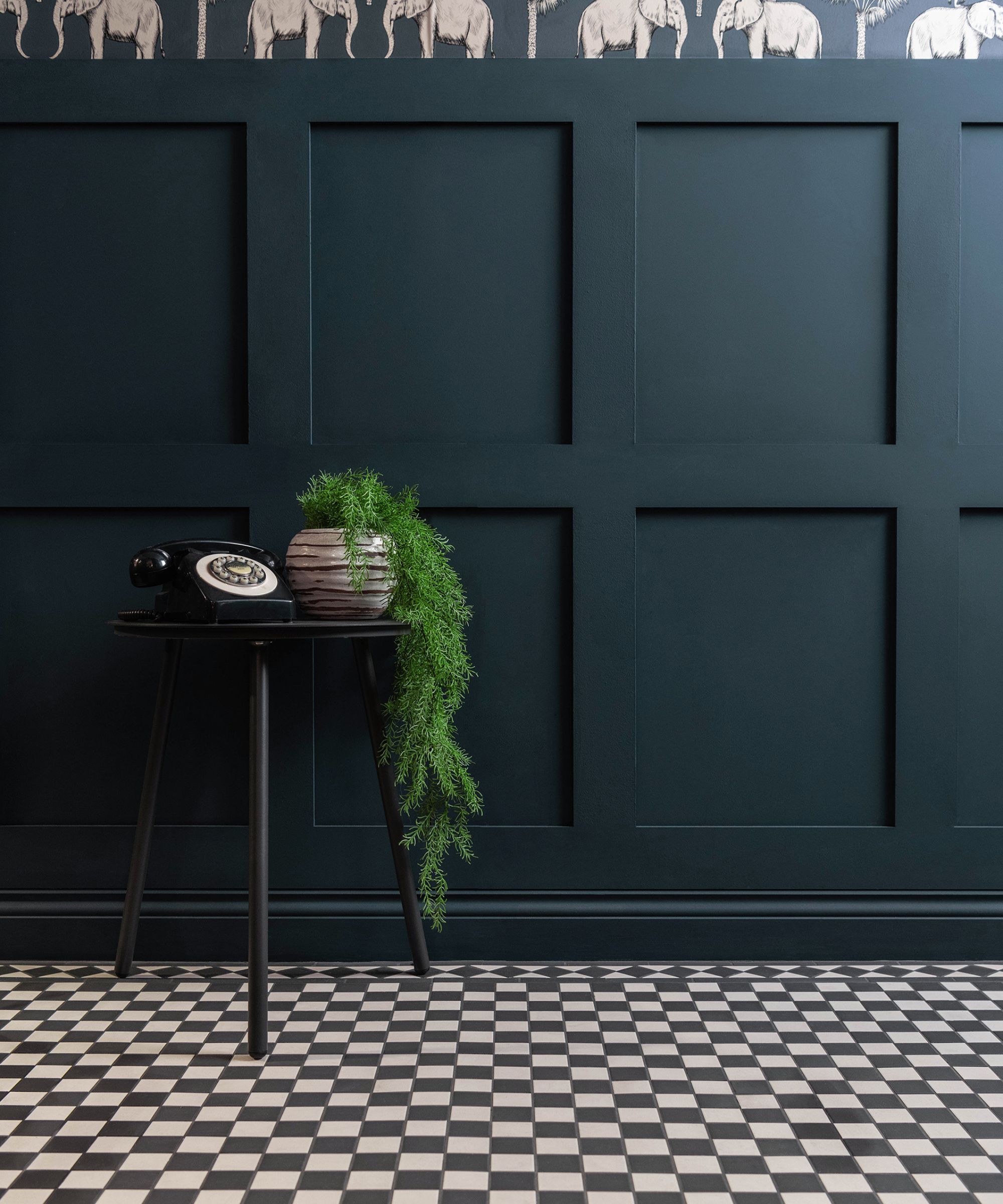
For a look that stands the test of time, you can’t go wrong with Shaker-style wall panelling. Known for its clean lines and classic design, Shaker panelling brings understated elegance to any hallway scheme. Its simple square frames add structure without feeling too busy, making it an excellent option for both modern and traditional style homes.
To recreate the look above, consider pairing Shaker-style panelling with bold, rich paint colours. Shades like navy, charcoal, or even forest green give the panelling a moody and timeless yet feel. Similarly, pairing dark Shaker panelling with whimsical patterned wallpaper creates a striking contrast that’s both playful and sophisticated.
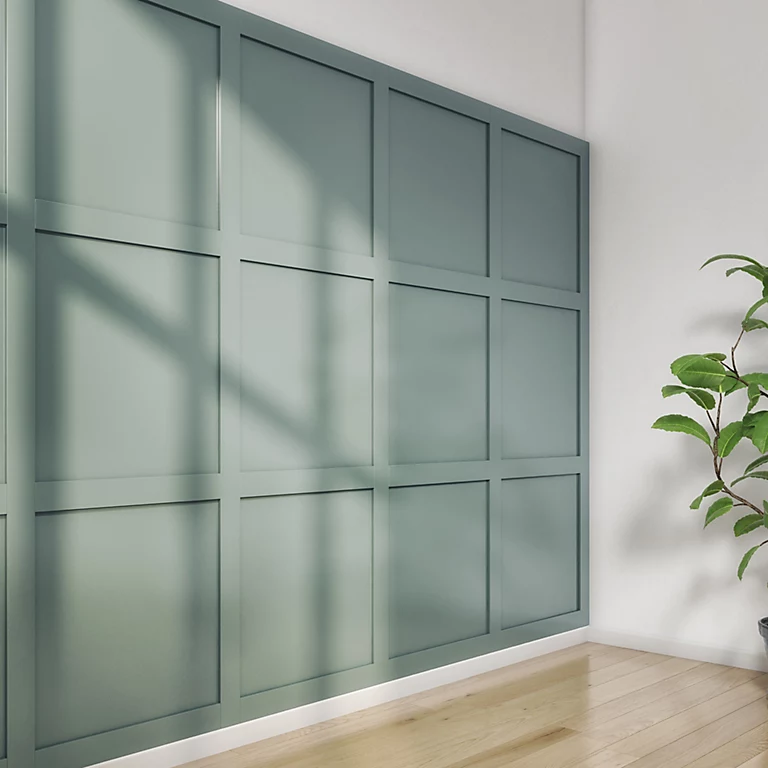
Why not give DIY Shaker wall panelling a go? This MDF kit covers approximately 1.2msq and is easy to fix to your wall with glue, nails or screws.
8. Blend your doors into your panels to create a 'hidden door'
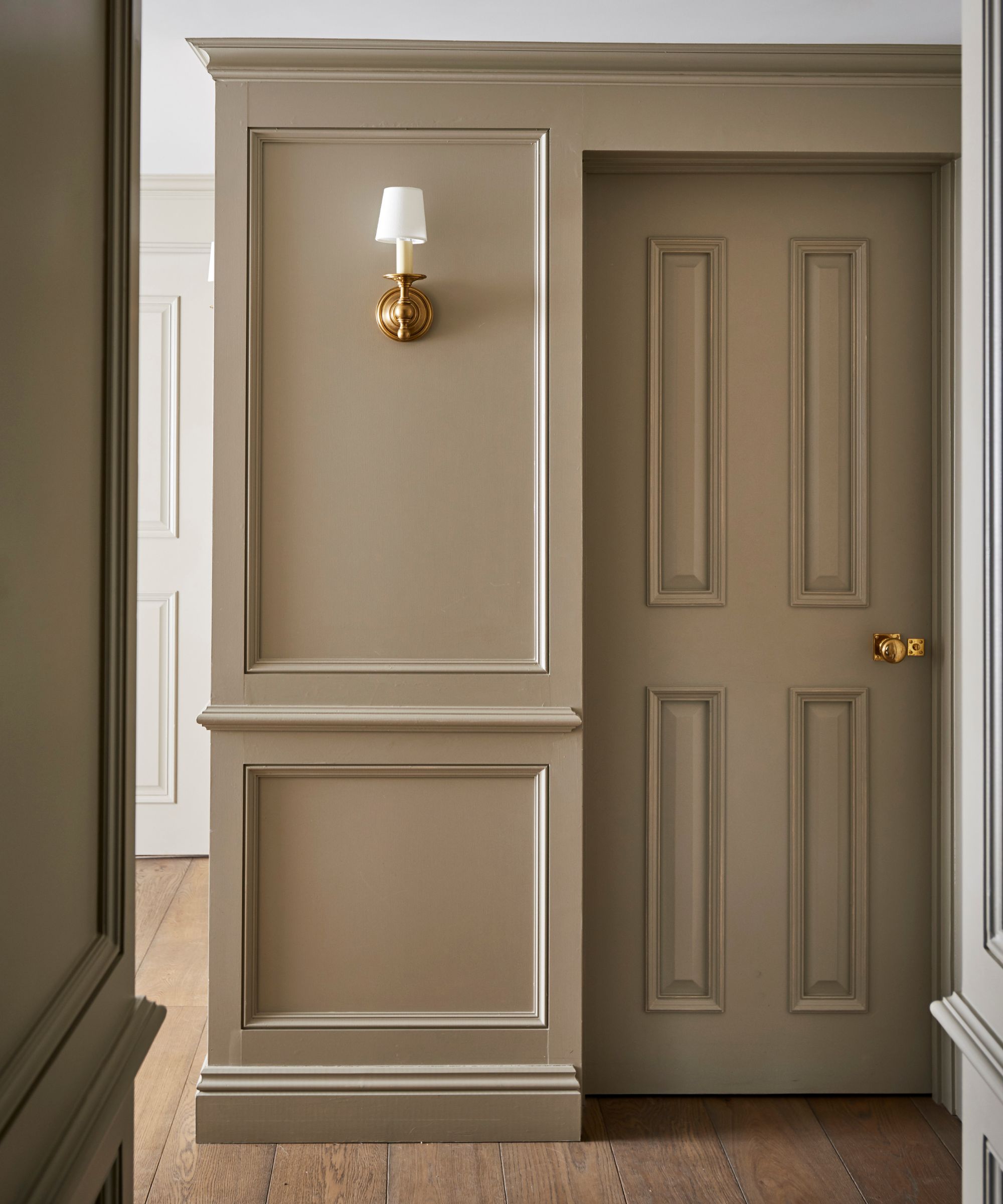
Who can resist the lure of a hidden door? Blending your hallway doors into the surrounding wall panelling creates an uninterrupted look that brings an air of sophistication and mystery to the space. By matching the colour and style of the door to your choice of panelling, you can make the door almost disappear.
In this example, the door is cleverly concealed by matching moulding and a uniform paint finish. Subtle detailing and a neutral colour palette keep the look feeling timeless and elegant, while the hidden door adds a playful element of surprise.
9. Integrate lighting into your designs
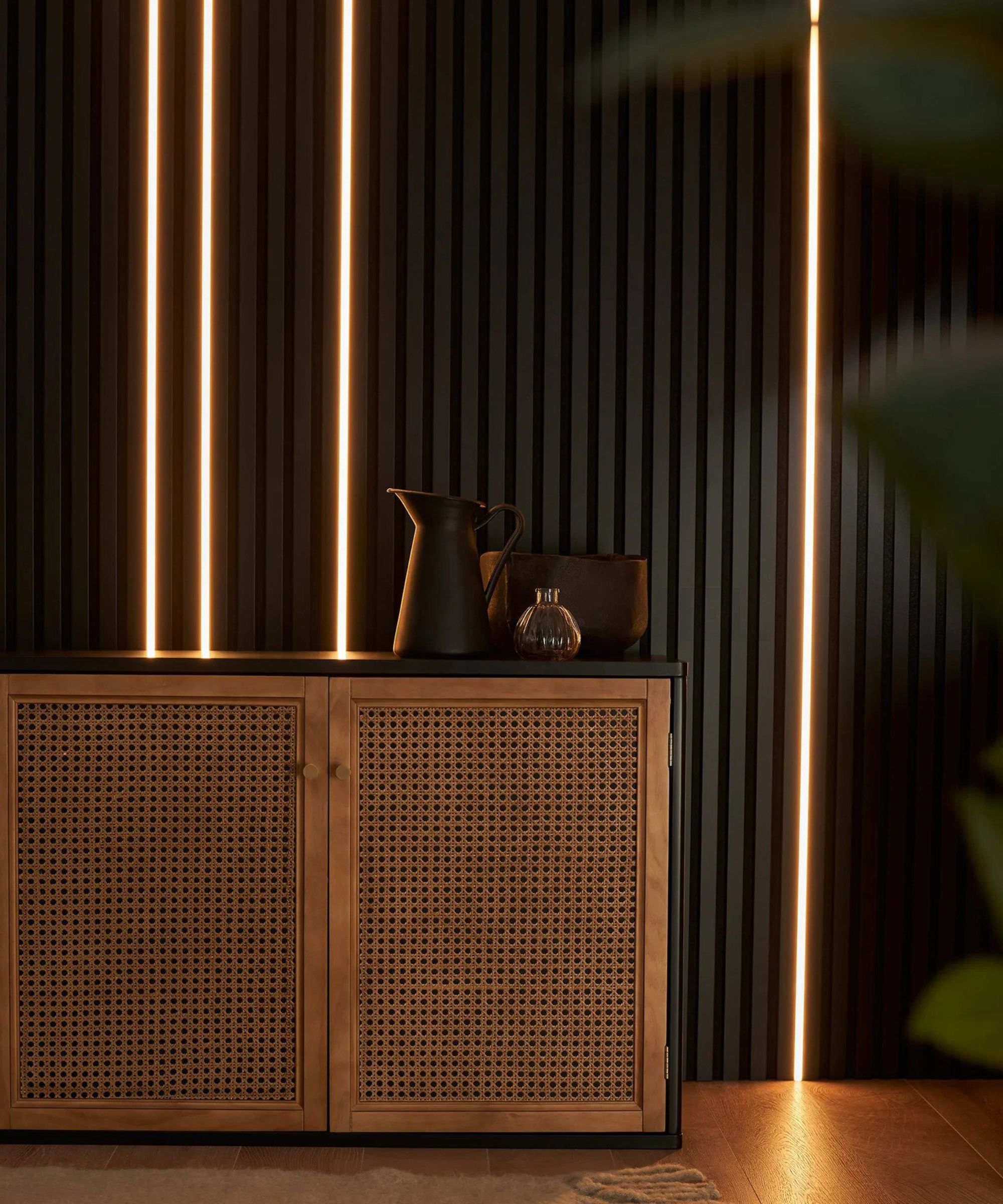
Hallway lighting is one of the easiest ways to enhance your panelling, instantly adding ambience while providing practical task lighting to guide the way.
"Adding LED strip lighting behind or within the panels can create a dramatic, illuminated effect that’s both functional and visually striking," says Jessica Davis from LL Company. By integrating lighting into your panelling design, you can also highlight the texture and detail of the panels.
For a subtle, modern touch, try placing LED strips behind the edges of the panels to softly illuminate the walls. For a bolder look, consider recessed lighting within the panels themselves, which can cast light directly onto the floor or accent specific features for a striking visual effect.
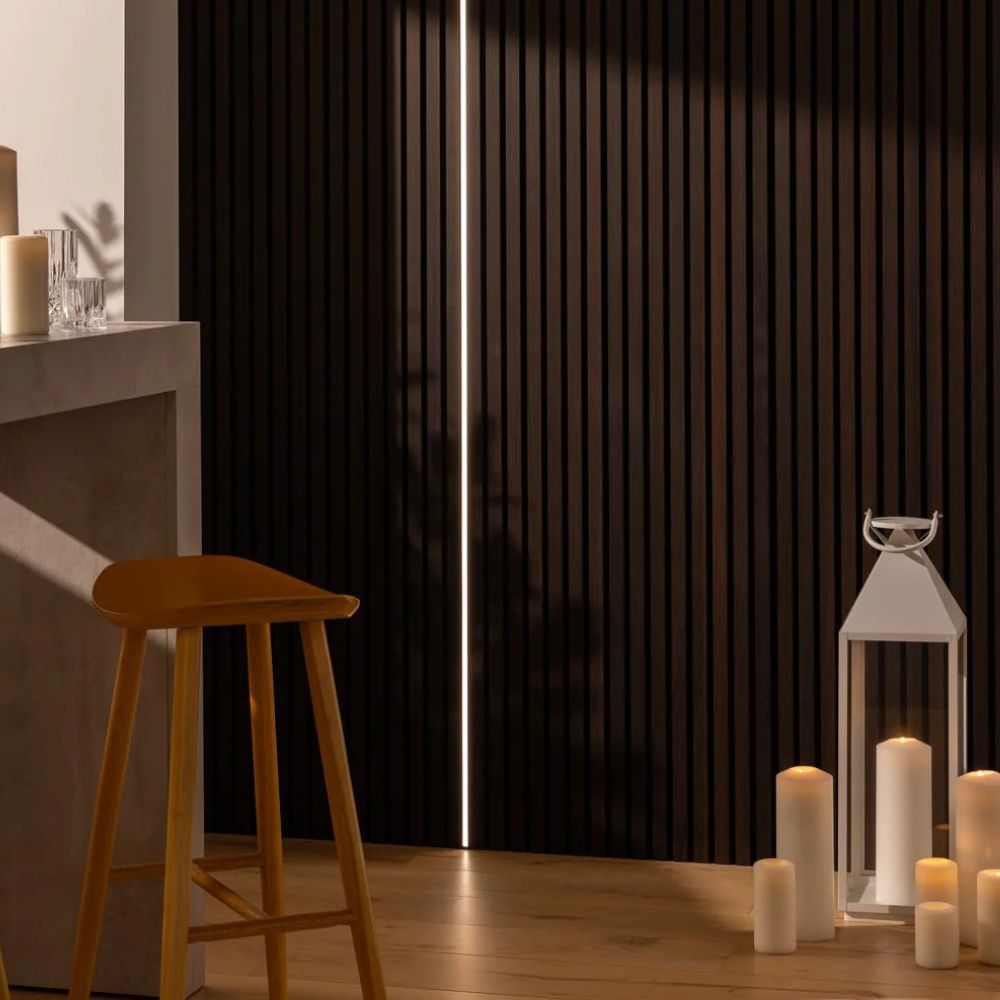
Each of these LUSTRE LED Kits includes adhesive LED tape, a black aluminium profile with diffuser, an LED driver, power adapter, and all necessary fittings for easy installation.
10. Add unique texture to your hallway panels
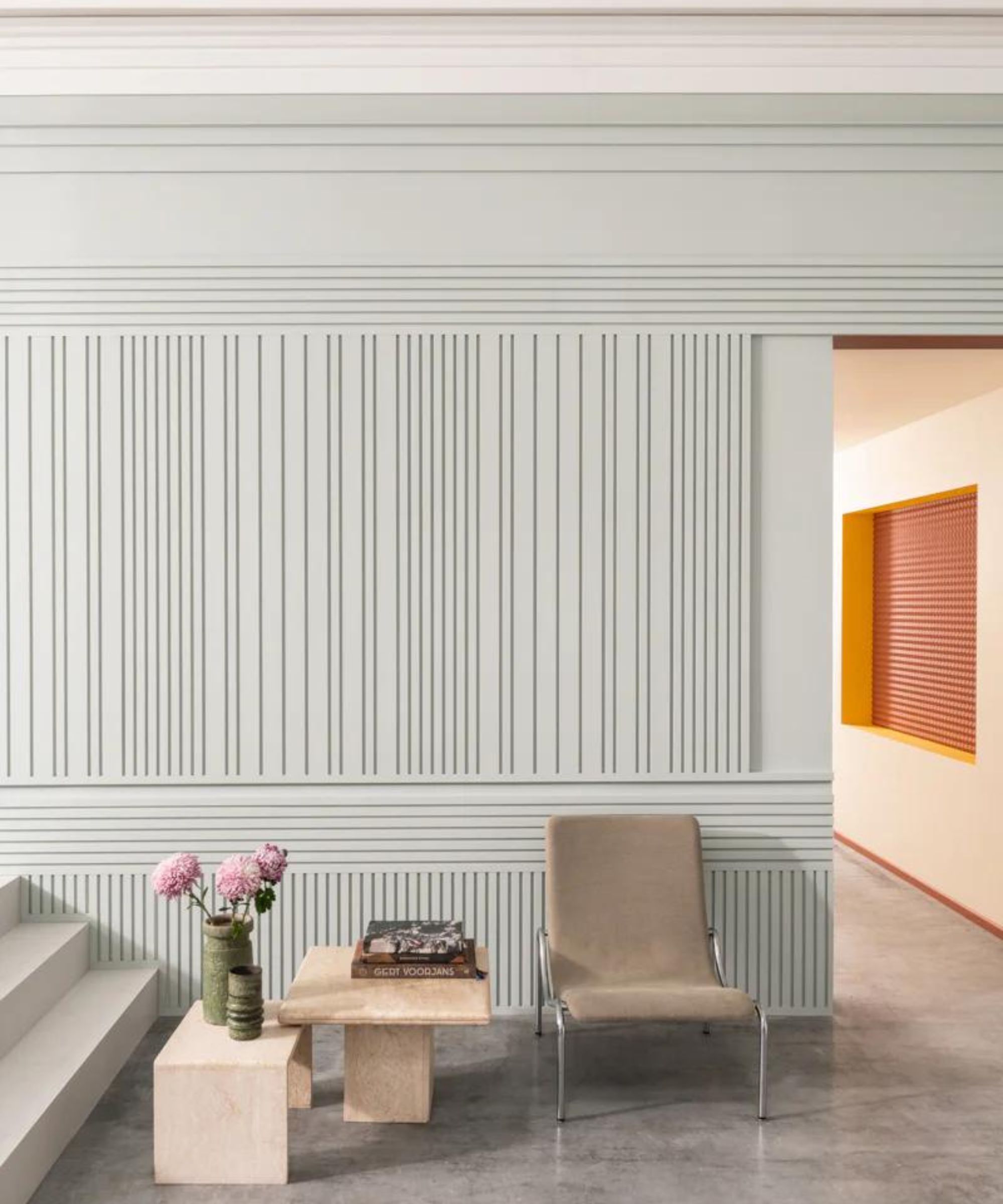
Want to elevate your hallway beyond the ordinary? Consider experimenting with textures and the direction of your wall panels.
"Panels with fluted or ribbed surfaces add depth and interest, making the hallway feel tactile and rich," explains Jessica from LL Company. "Don't shy away from mixing different panel heights or combining styles to create an unexpected but cohesive look."
In this example, the combination of vertical and horizontal panelling creates a truly bespoke, textured finish. While this combination of directions could feel too busy, the soft, neutral tones keep the look feeling understated – adding interest while maintaining a clean, minimalist style.
11. Opt for low wall panelling to subtly add character
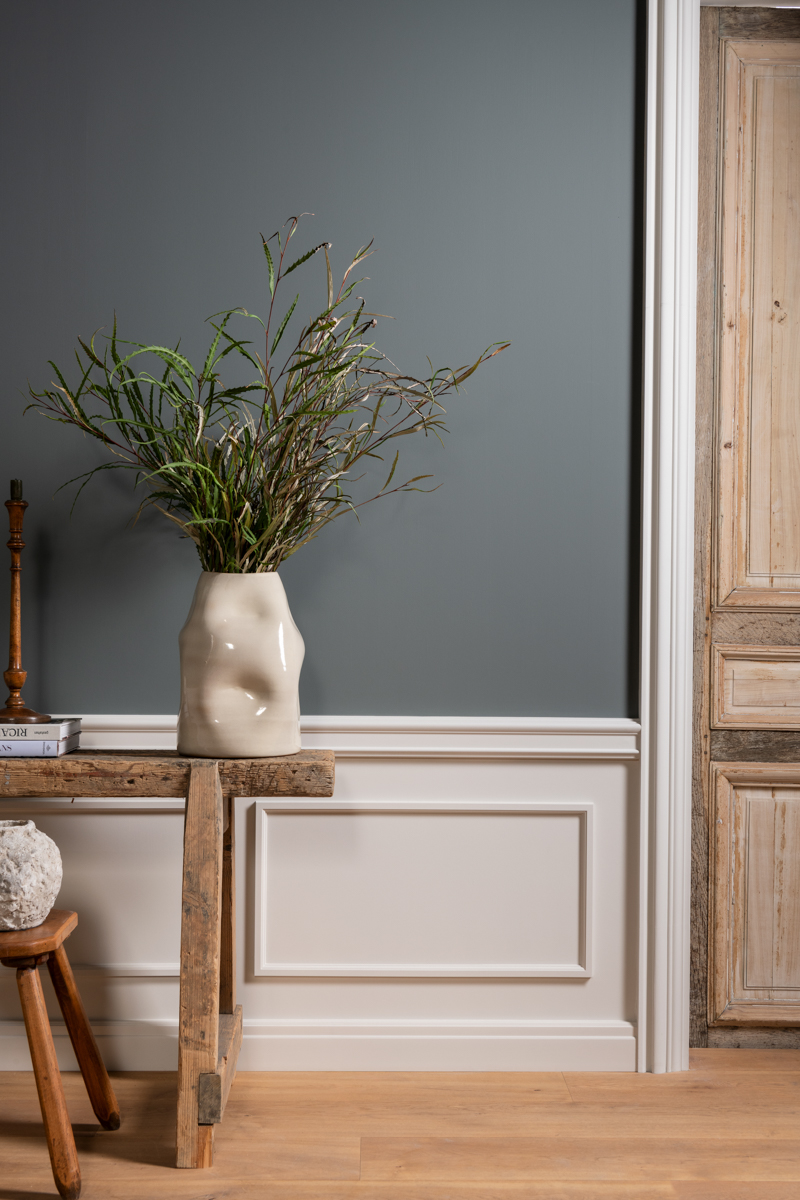
If you're looking for a subtle way to add interest to your hallway without overwhelming the space, opt for low wall panelling. These shorter panels offer just enough structure and visual detail while keeping the upper part of the wall open for bold colours, artwork, or other design features.
In this hallway design by the LL Company, the low panelling is painted a soft, neutral white, providing a crisp contrast against the deeper wall colour above. The height of the panelling allows the space to feel open and airy, while still offering a little texture and dimension.
12. Don't shy away from asymmetrical or geometric designs
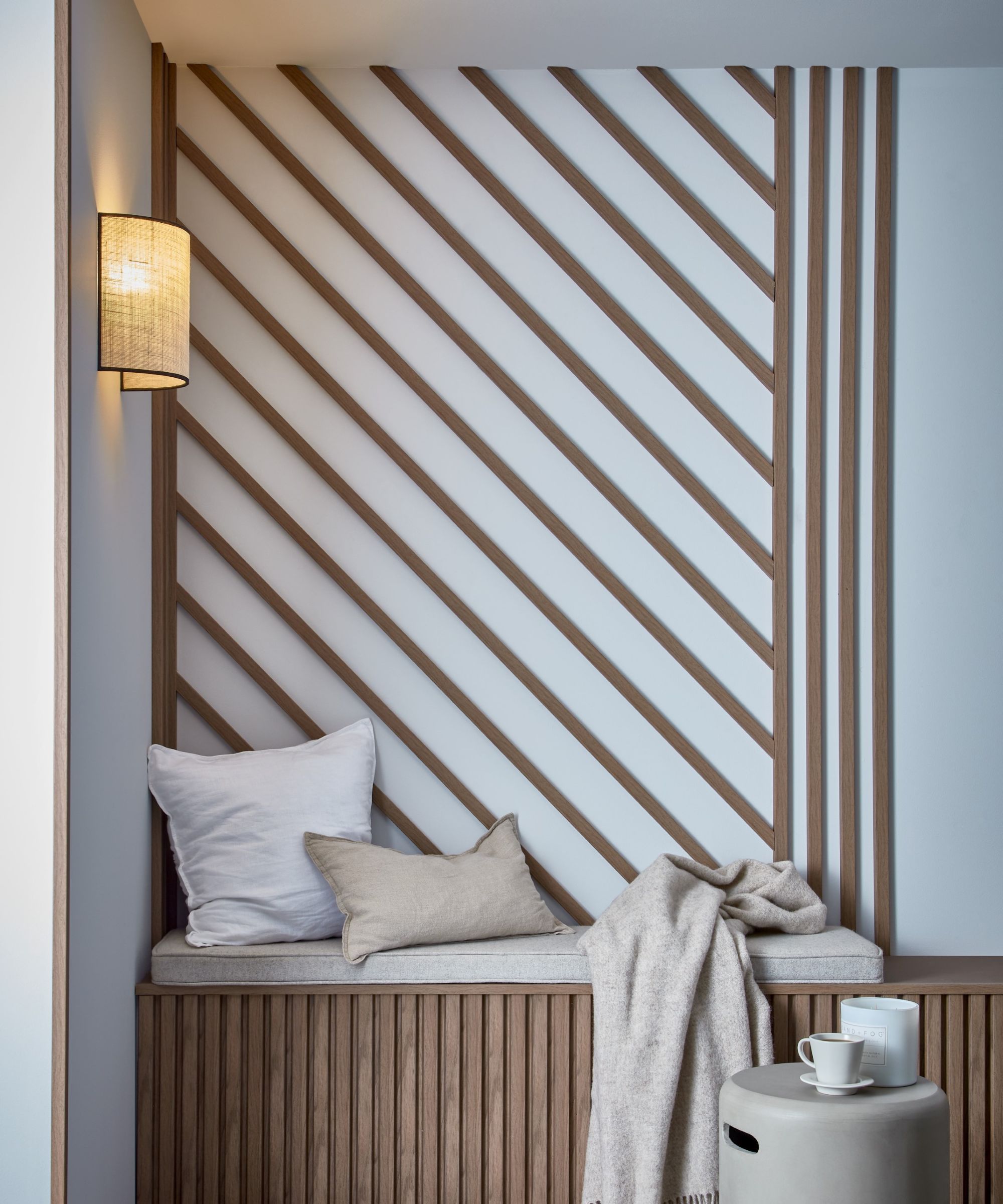
"Break away from symmetry by creating asymmetrical panelling layouts," recommends Jessica from LL Company. "Vary the size or positioning of panels to add an element of surprise and uniqueness to your hallway."
"Instead of traditional vertical or horizontal panels, consider diagonal or patterned designs for a modern edge," Jessica adds. 'You can also play with scale and pattern to create something that feels distinct – whether it’s oversized panels or a mix of textures that reflect your personality."
13. Use integrated artwork or wallpaper for a one-of-a-kind design
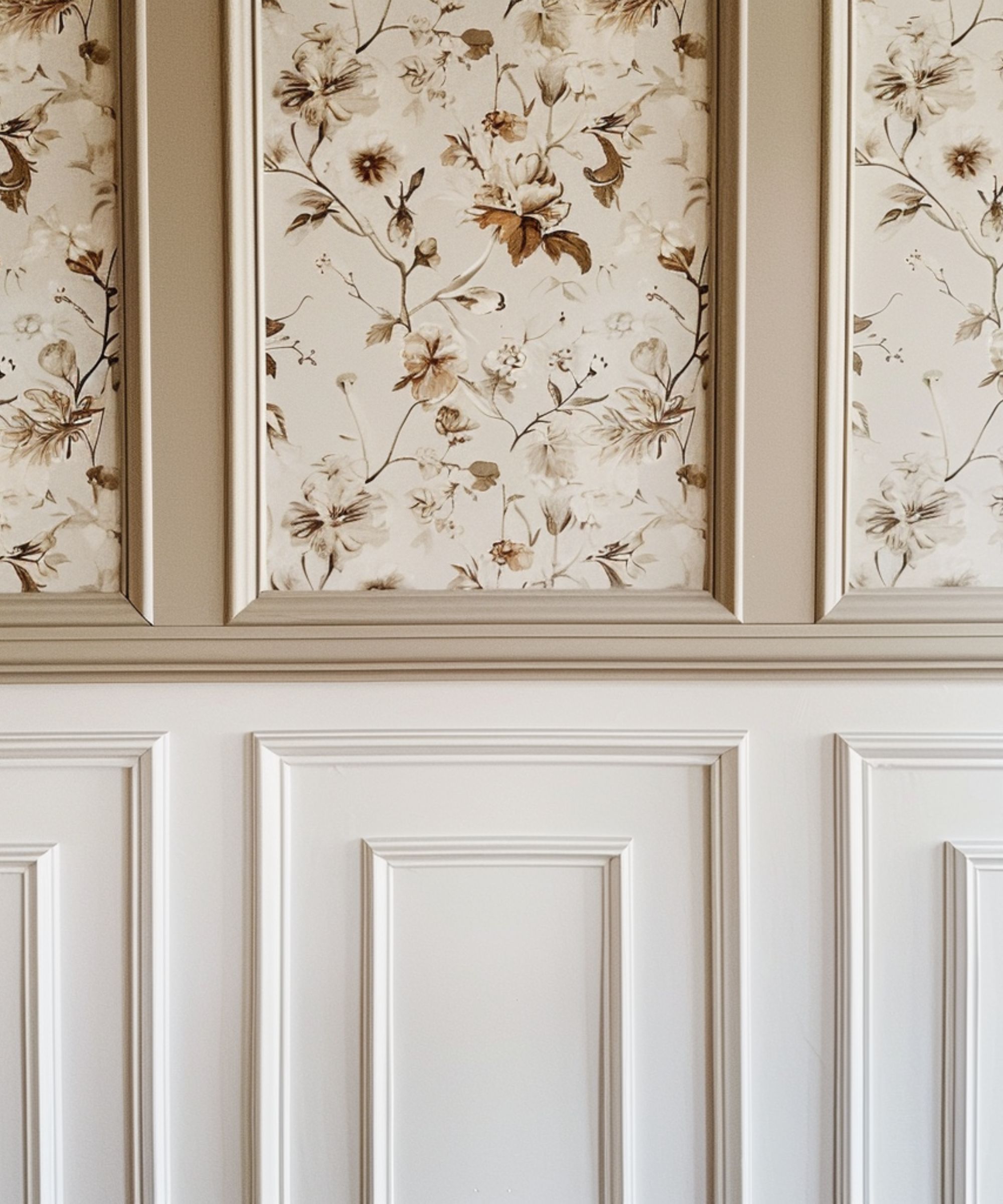
For a one-of-a-kind look, Jessica Davis suggests creating custom hallway wall panels with built-in spaces for artwork. "Whether it’s framed paintings, photography, or even decorative objects, integrating personal style into the panelling design allows your hallway to make a unique statement," she explains.
Jessica also recommends considering custom details like unique trims, mouldings, or personal touches such as picture-frame panelling for displaying family photos. "You can even incorporate inlaid materials like fabric or wallpaper for added texture," she says. Mirrored sections within the panelling are another great option, as they reflect light to make smaller hallways feel more spacious.
14. Colour coordinate your wall panels with your floor
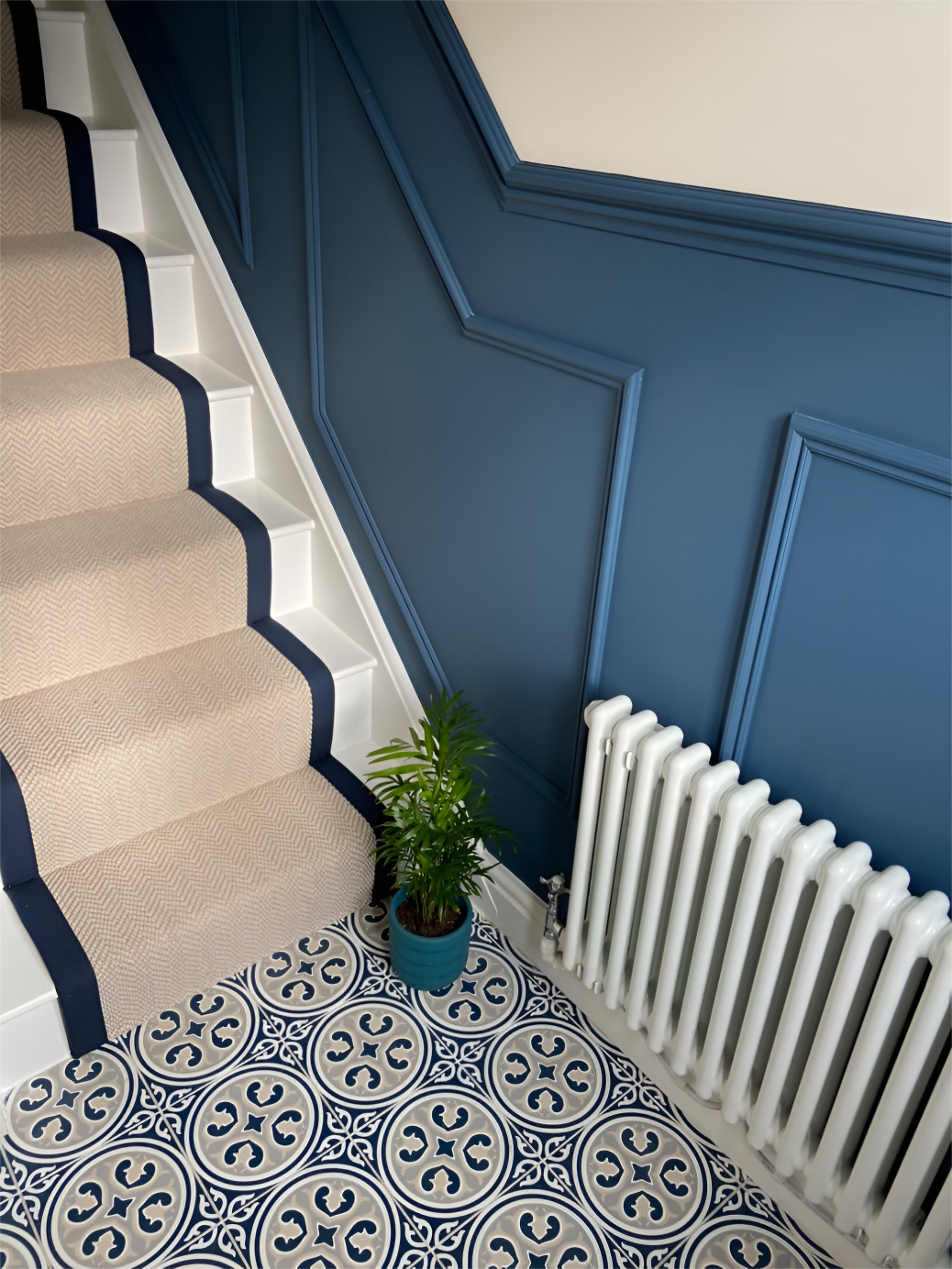
For a cohesive modern hallway scheme, why not colour coordinate your wall panels with your hallway floors? Matching or complementing the colours between these two elements creates a harmonious flow that ties the space together beautifully.
In the above example from Tapi Carpets and Floors, the bold blue wall panelling perfectly mirrors the deep blue tones in the patterned floor tiles. This matching palette draws the eye naturally through the space and up the stairs.
15. Use contrasting colours for an impactful design scheme

"Use can use two-tone panelling with contrasting colours to create visual interest," recommends Jessica Davis. "For example, darker tones on the lower panels paired with lighter shades on top can create a sophisticated, layered look."
This two-tone technique is perfect for those looking to add drama and style to their hallway while keeping the design balanced and refined.
16. Or go for a bold and striking colour for an impact feature wall
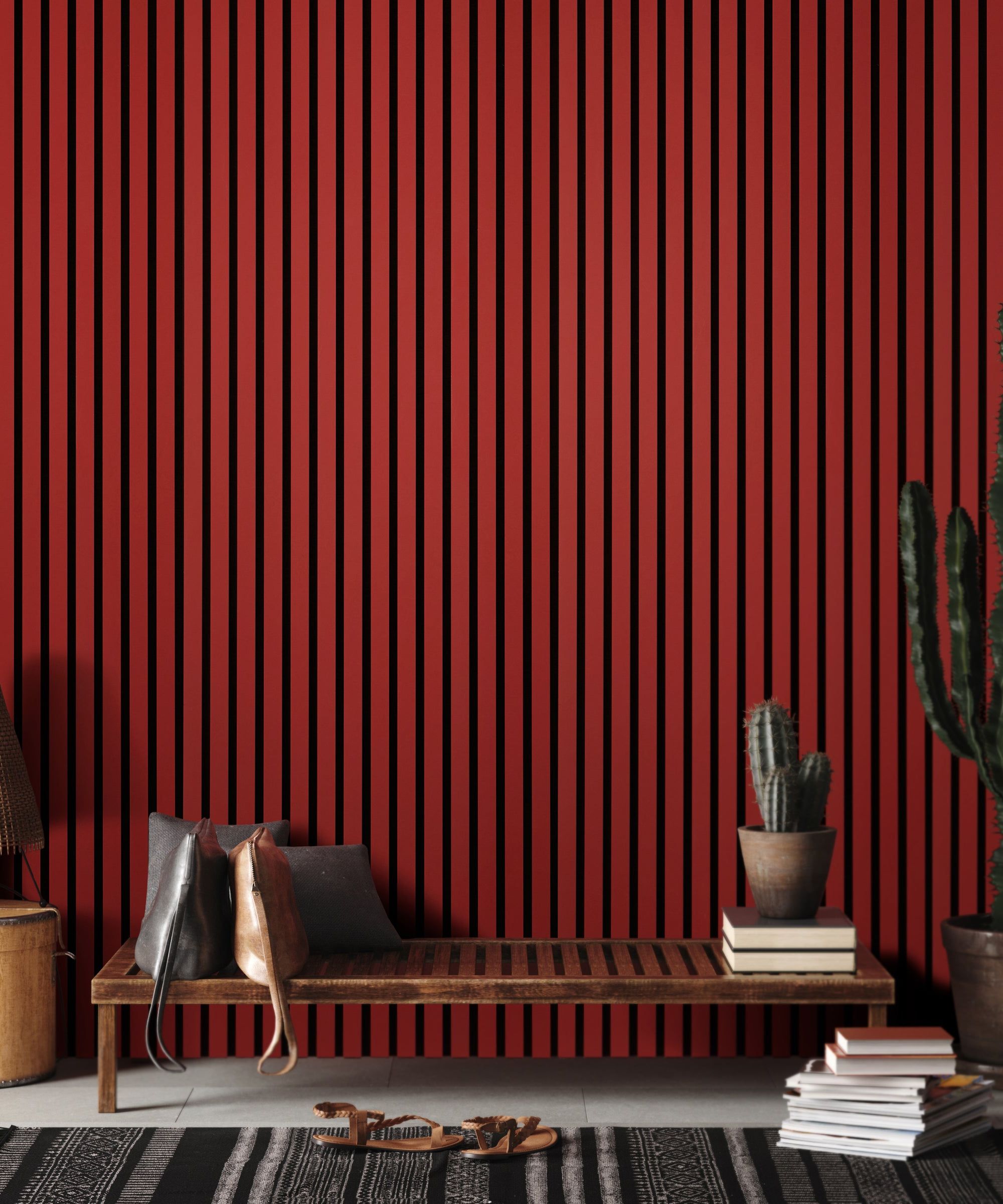
If you’re looking to make a statement, why not go all in with a bold feature wall? This is a fantastic way to turn your hallway into a standout space without overcomplicating the design.
"Bringing colour into your hallway panelling is actually a pretty easy job that will make a big difference in how you see the space," says Courtney Cole, interior designer and founder of Australia-based TileCloud. "If you paint the walls in a bold shade, you can create a statement wall that will turn your hallway from run of the mill to a standout feature in the home."
A feature wall painted in a rich, dramatic hue, such as this red design by The Wood Veneer Hub, can instantly create a focal point, adding personality and depth to your space. If you have a long hallway, a feature wall at the end can create a sense of destination, making the space feel both purposeful and stylish.

As an interior designer at TileCloud and sister company Yabby, Courtney brings a wealth of knowledge and expertise to the world of home renovation. With a Diploma in Interior Design and Decoration and a passion for creating stunning interiors, she's dedicated to helping people on their journey to transform their homes.
17. Pair half-wall panels with a statement wall mural
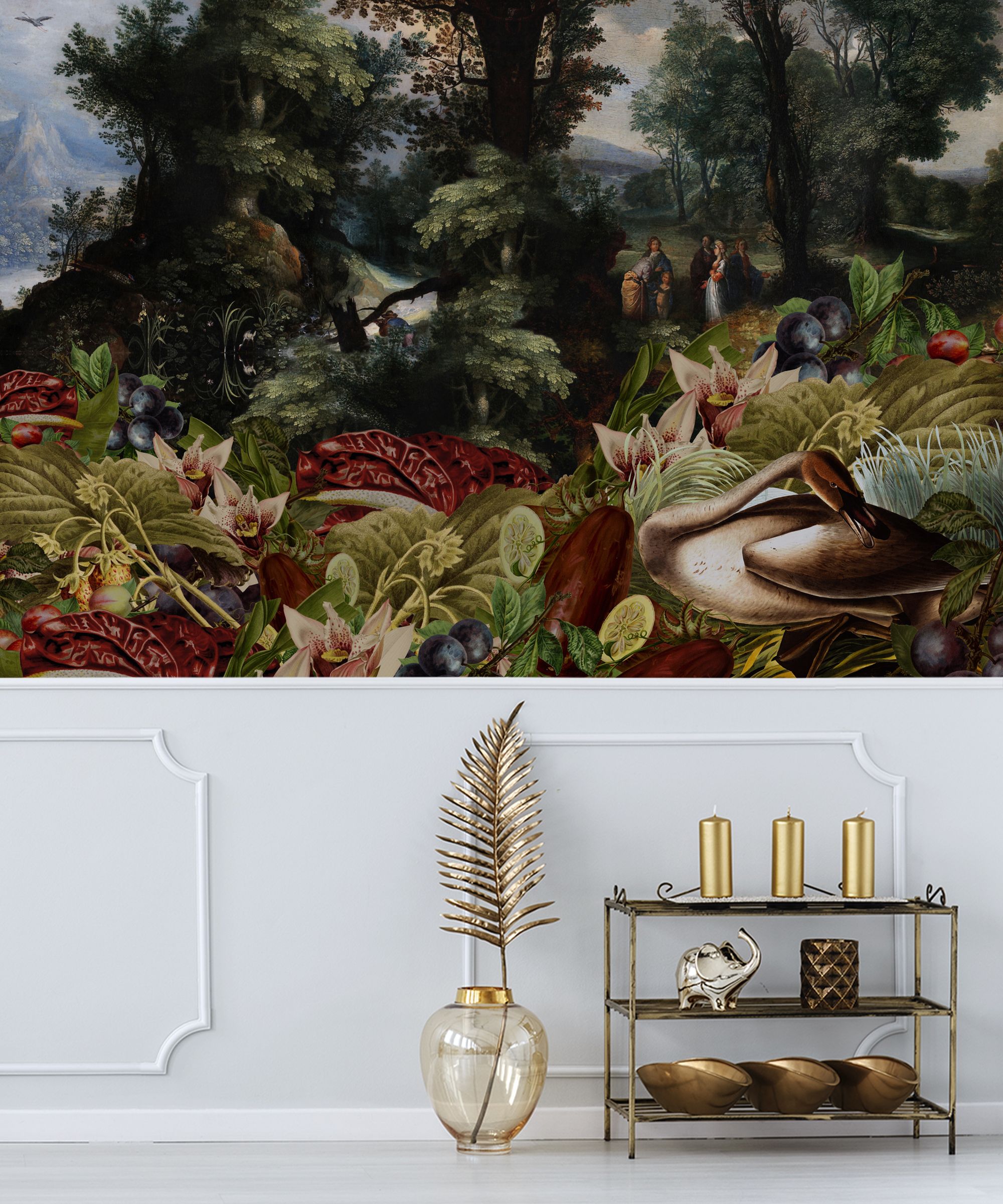
For a hallway that really makes an statement, try pairing half-wall panels with a bold wall mural design. In this example, the white half-wall panelling keeps things simple and classic, while the colourful, nature-inspired mural adds personality and interest to the space.
If you choose this option, consider painting the lower half of the wall in a muted shade. However, if you’re a fan of the maximalist look, a bold-coloured half-wall panel paired with playful wallpaper might be more your style.
18. Continue your hallway panelling up your staircase
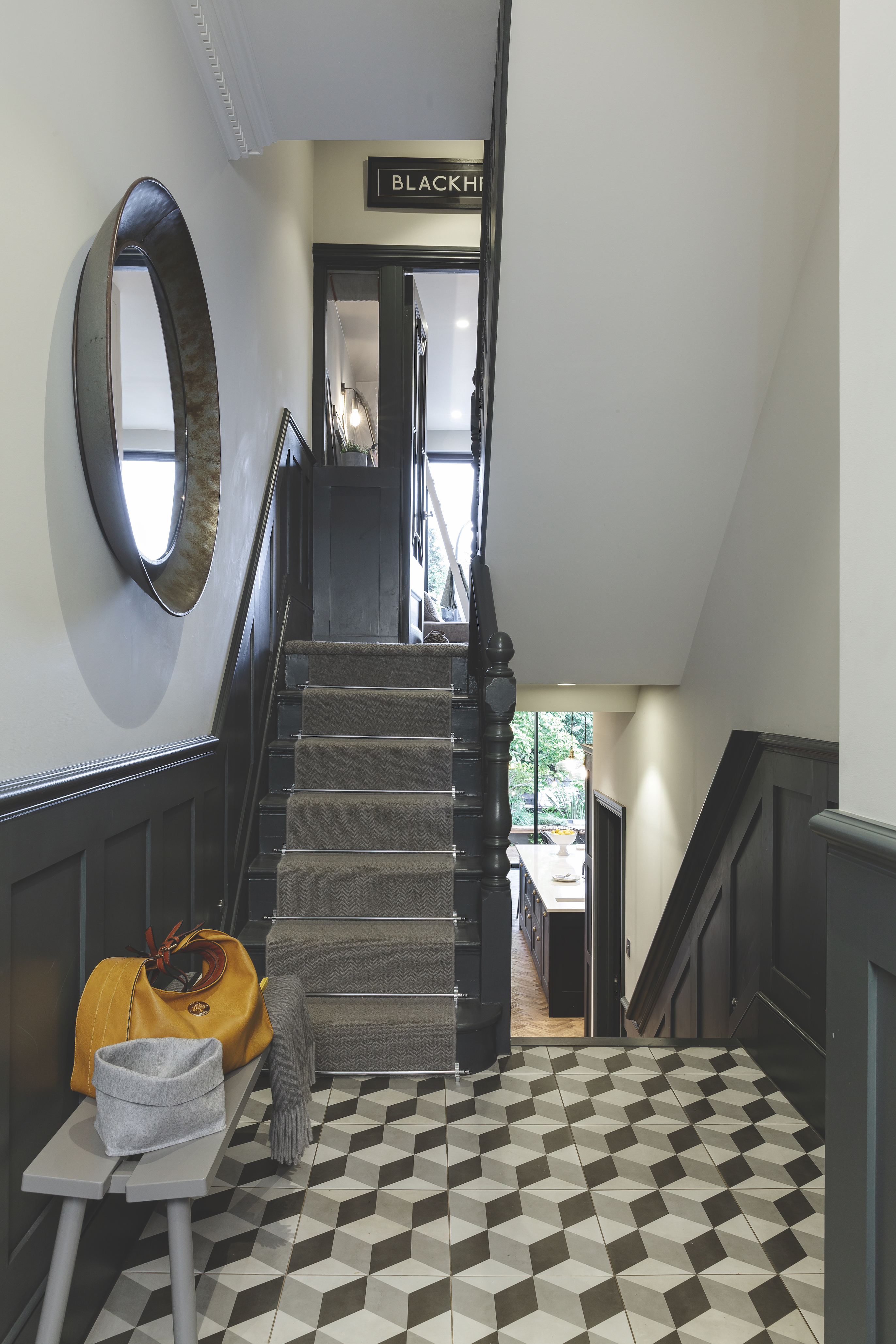
For a cohesive look throughout your home, continue your hallway panelling up your stairs. Extending the panelling from the hallway to the stairs creates a seamless flow, which works particularly well in narrow or multi-level homes, drawing the eye upwards and highlighting the architectural features of the staircase.
In this example, the dark panelling begins in the hallway and carries up the stairs, complementing the traditional bannister and bringing a touch of elegance to the staircase design. Paired with geometric floor tiles and a neutral carpet runner, the panelling ties the spaces together.
18. Install minimalist vertical panelling for added height
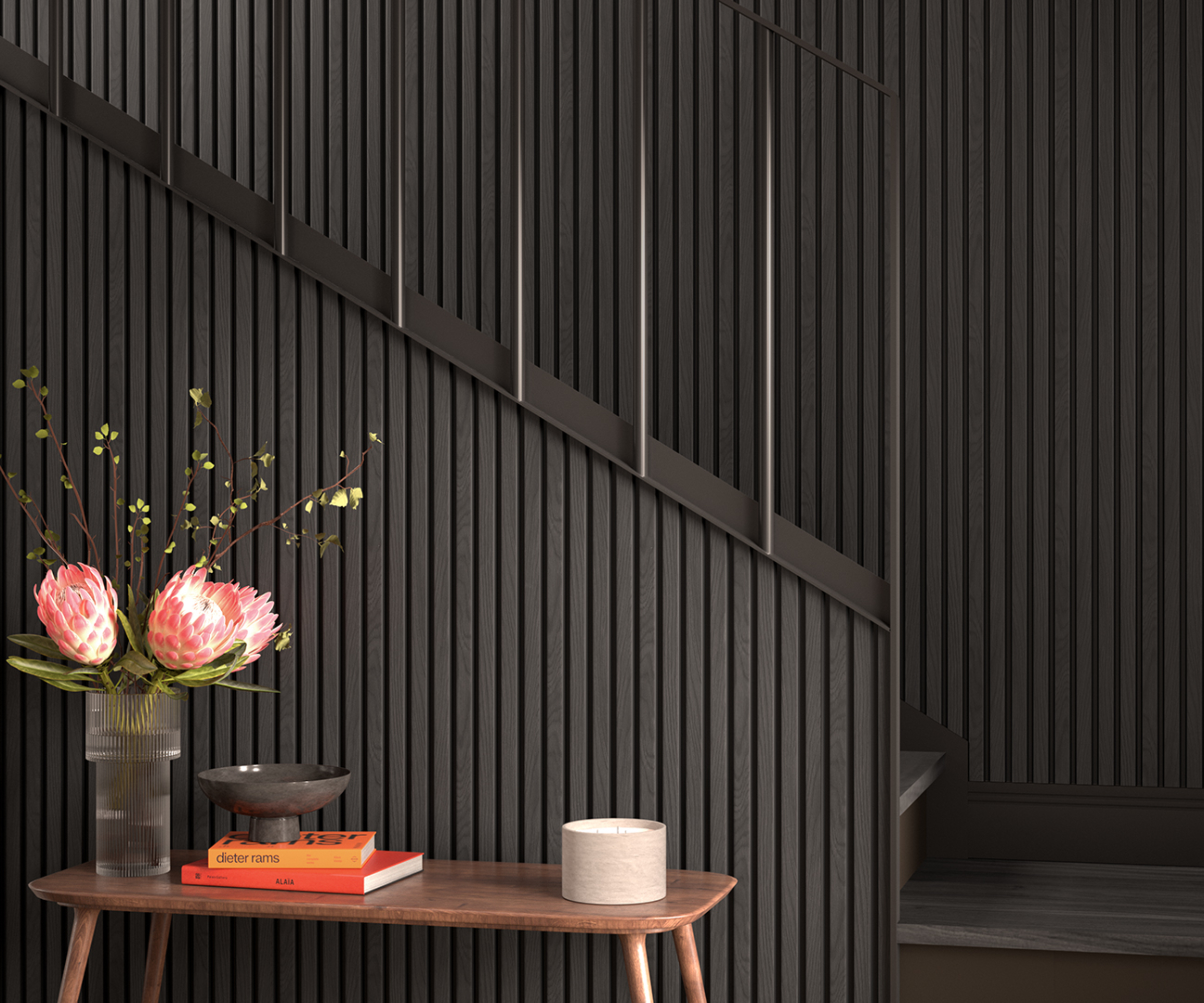
If you want to make your hallway feel taller and more spacious, install minimalist vertical panelling. This design trick draws the eye upwards, creating the illusion of added height. The clean, simple lines of vertical panels are perfect for smaller spaces, as they help elongate the walls without overwhelming the room with too much detail.
Minimalist vertical panelling works well in modern homes and can be painted in a range of colours to match your aesthetic. For a sleek, airy look, go for light or neutral shades. Alternatively, if you’re after more drama, opt for a dark, moody colour to add contrast while still benefiting from the height-boosting effect.
19. Delineate spaces in your hallway using slated panels
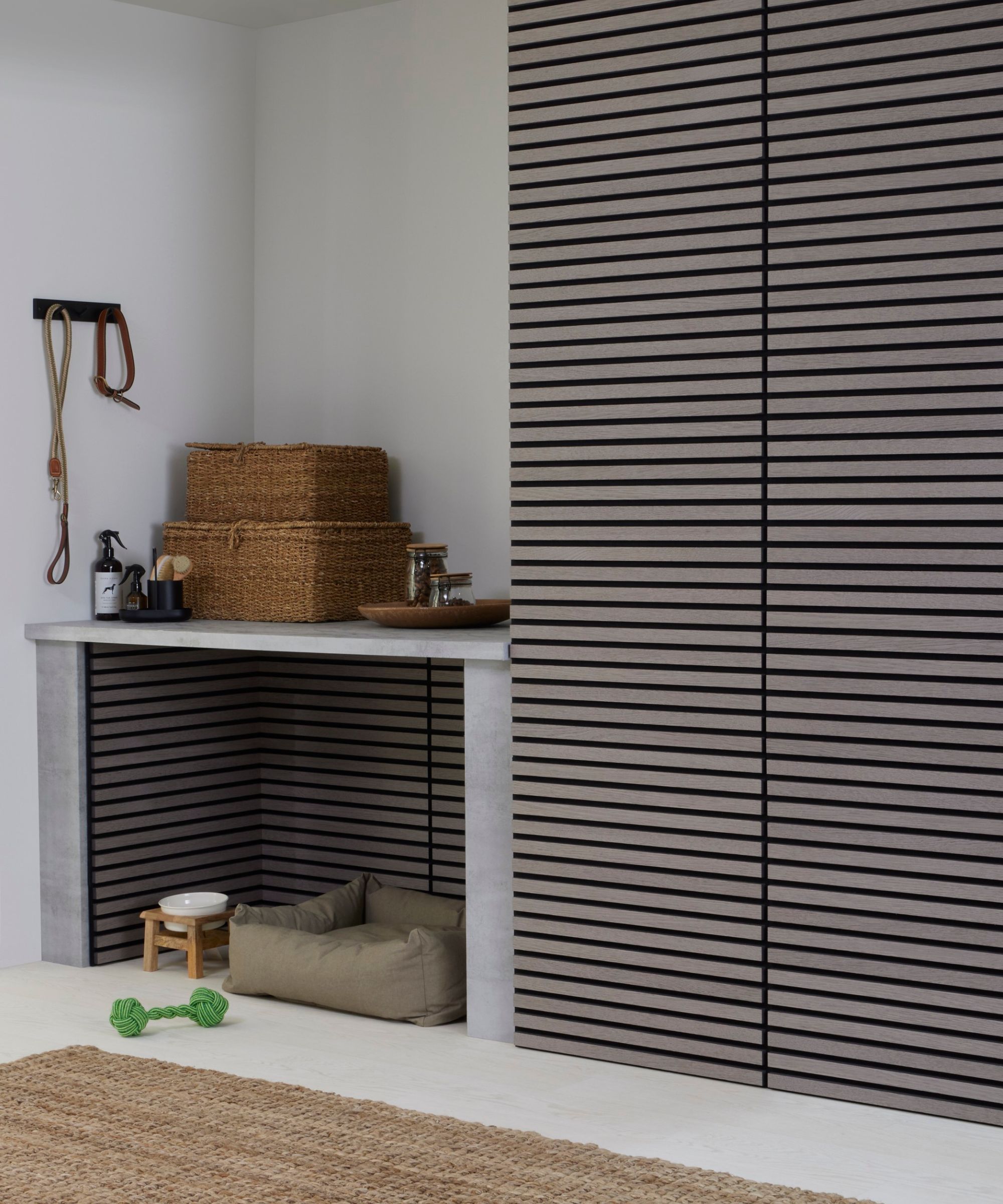
Slatted panels are a great way to delineate spaces in your hallway while maintaining an open and airy feel. Whether you want to create subtle divisions between areas or add texture to your walls, slatted panels offer a modern, minimalist solution that’s both functional and stylish. In this example, the slatted panels not only separate the space but also create a functional spot for a dog bed, cleverly utilising an otherwise underused area.
20. Use reclaimed wooden boards to add warmth to a hallway
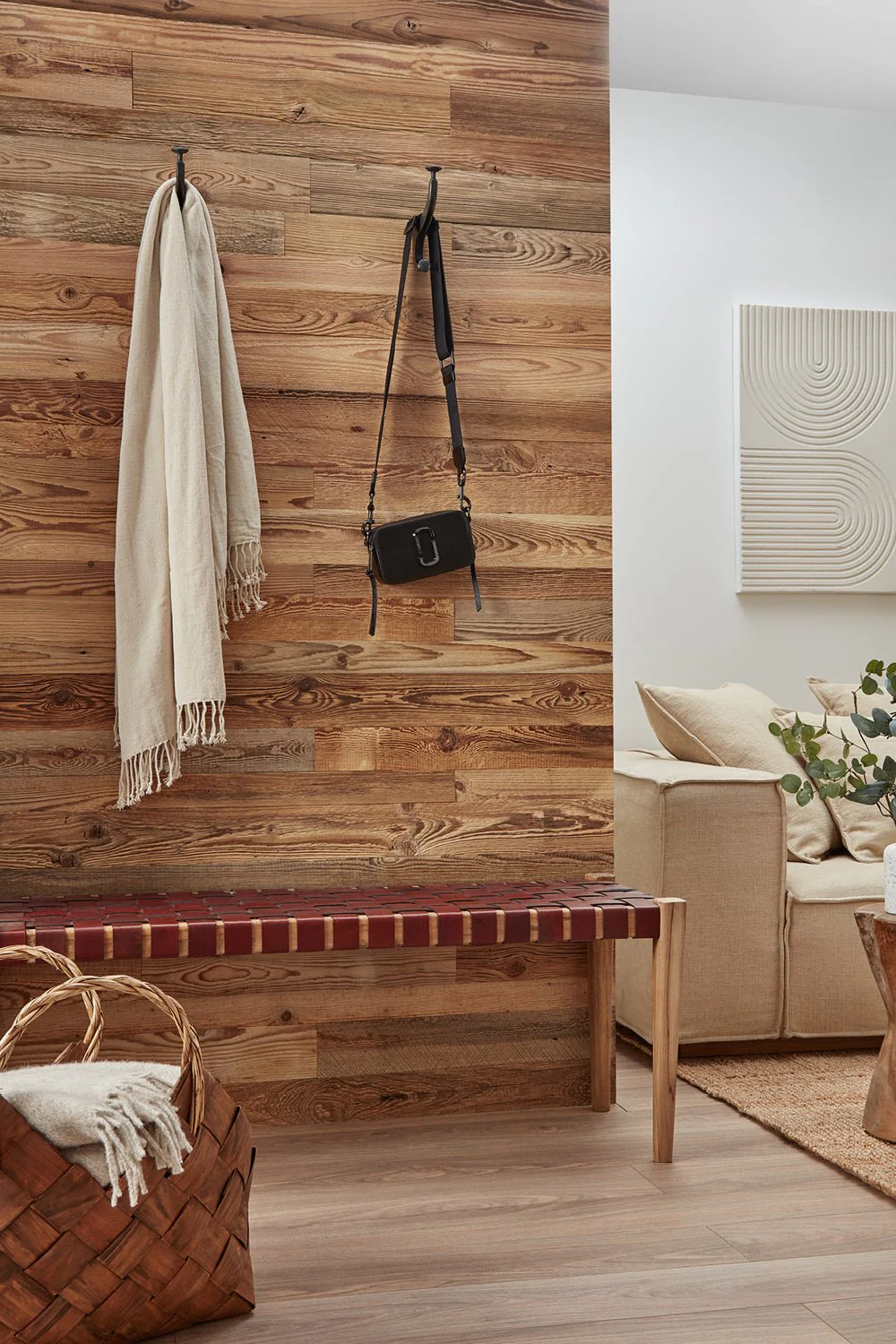
Adding reclaimed wooden boards to your hallway is a fantastic way to introduce warmth and character to the space. The natural tones and textures of reclaimed wood bring a sense of history and charm, while also making your home feel cosy and inviting. Plus, using reclaimed materials is a sustainable design choice that gives new life to old materials.
FAQs
Can panelling help with acoustics or insulation in a hallway?
According to Olivia Crosher, Interior Designer at Naturewall, "Panelling is a great option for improving acoustics in a hallway, particularly wood slatted panels with felt backing. This combination of form and materials dampen the noise, creating a calm and quiet space as you enter your home, a great way to transition from the outdoors to the indoors."
How easy is it to DIY your hallway wall panelling?
"If you want to DIY wall panels, there are a few things you should do before you get started," explains interior designer, Courtney Cole. "First things first, if your hallway is wonky or has walls that are uneven, you should talk to a professional before you kick off the job. If you’ve pulled out the level and you’re certain the walls are straight, then look into panel options like medium density fibreboard (it’s durable, easy to paint, and budget friendly)."
"If you’ve done a few DIY jobs in the past, then DIYing wood panels won’t be an issue for you - especially if you have the right tools. If you go for pre-cut panels or wood strips, these can easily be adhered to the walls. The biggest issue you might have will be being patient and precise - this will ensure the panels are even and level."
For comprehensive step-by-step instructions, read our guide to DIY wall panels.
What is the best type of paint for hallway wall panels?
"Experimenting with paint finishes, such as matte or high gloss, can give standard panelling a more personal feel," explains Jessica Davis from LL Company. In terms of the best to use on hallway panels, "We recommend using Mylands Wood & Metal Paint which are good for both interior and exterior and come in three different finishes: Matt, Eggshell or Gloss."
Homebase offers Dulux Trade Satinwood Paint, which is perfect for hardworking spaces, while DIY.com sells hardwearing Vitro Chalk Paint in a range of affordable colours.
For designer shades, try the Farrow & Ball Interior Metal & Wood Paint collection or Little Green Intelligent Satin.
Once you have decided on the best wall panels for your hallway, don't neglect your hallway decor ideas. It's those finishing touches that can truly transform your hallway into a welcoming space.
Get the Homebuilding & Renovating Newsletter
Bring your dream home to life with expert advice, how to guides and design inspiration. Sign up for our newsletter and get two free tickets to a Homebuilding & Renovating Show near you.

Gabriella is an interiors journalist and has a wealth of experience creating interiors and renovation content. She was Homebuilding & Renovating's former Assistant Editor as well as the former Head of Solved at sister brand Homes & Gardens, where she wrote and edited content addressing key renovation, DIY and interior questions.
She’s spent the past decade crafting copy for interiors publications, award-winning architects, and leading UK homeware brands. She also served as the Content Manager for the ethical homeware brand Nkuku.
Gabriella is a DIY enthusiast and a lover of all things interior design. She has a particular passion for historic buildings and listed properties, and she is currently in the process of renovating a Grade II-listed Victorian coach house in the West Country.
